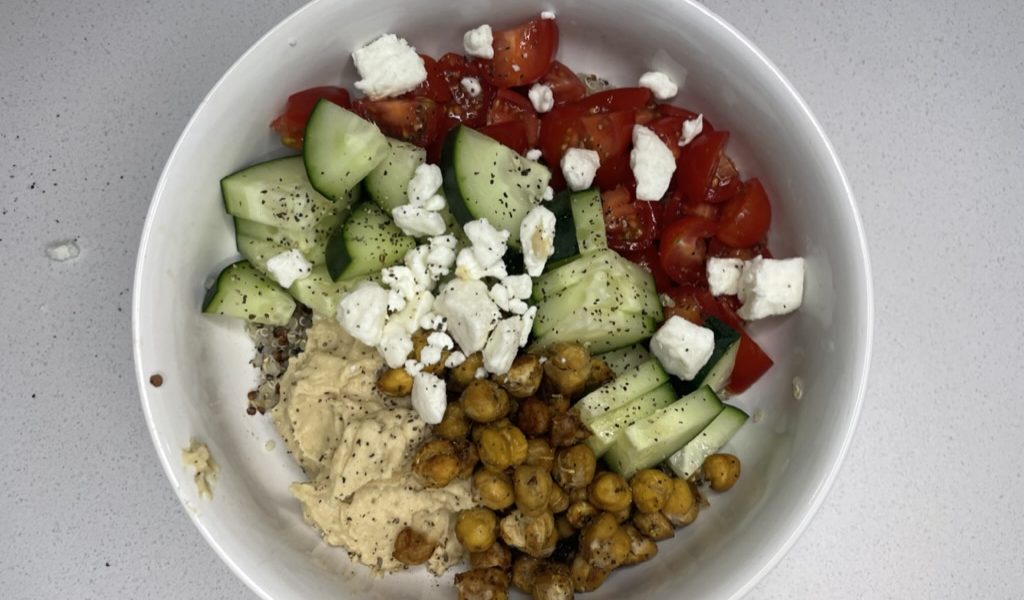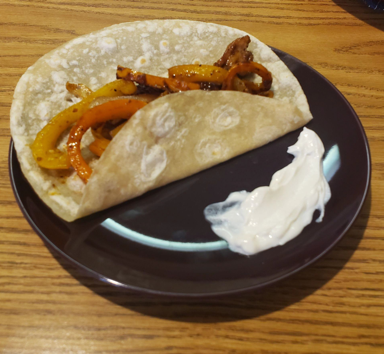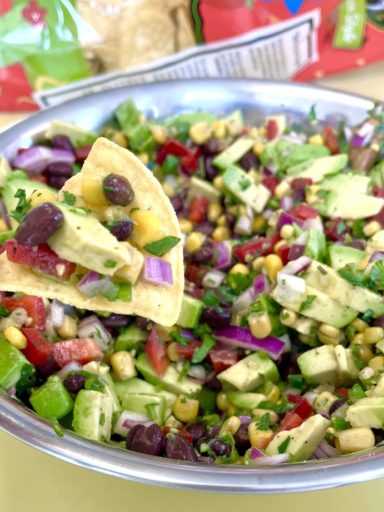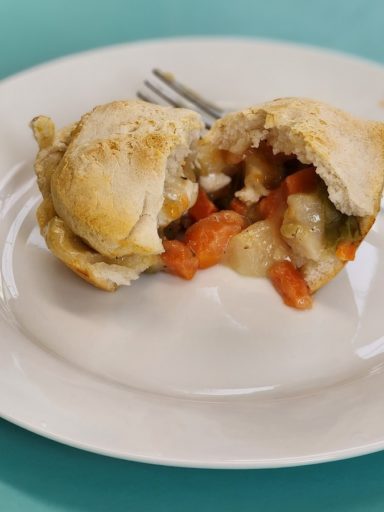Cooking and eating healthy can be really intimidating in college. When cost, time, and sustainability concerns are added to this it can be even harder to know where to start. Below I’ve given some information on eating healthy/sustainably while in college. The recipe further down is a great way to start down the path of healthy sustainable eating. It can be made as a dinner for a few people or prepared as lunches for the week.
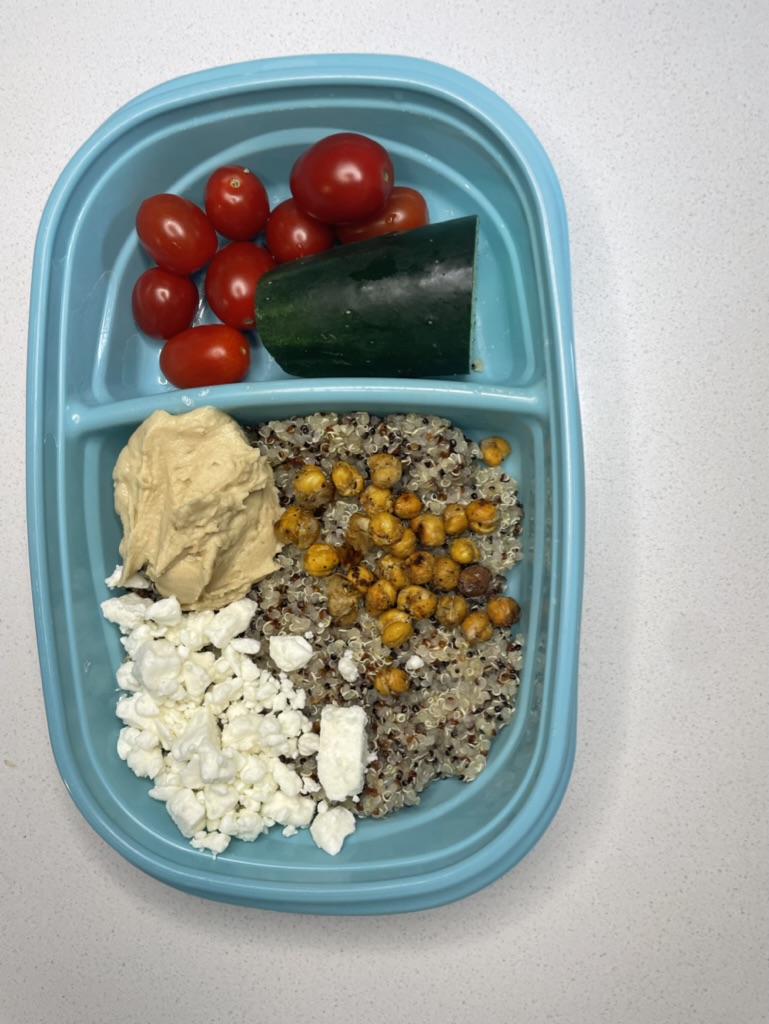
How can I start eating healthy when I’m in college?
I sent out a survey to some college aged individuals who attend various universities (primarily Utah State University and Texas A&M students) to figure out what most people struggle with to make a balanced diet. Most of the responses showed a high intake of meat and refined grains (think white rice, normal flour, white bread, etc.) and a low intake of vegetables and whole grains. Vegetables are jam-packed with nutrients our body needs. Whole grains are important to provide us with healthy carbs and fiber; certain grains are also a great source of protein and other nutrients. Young adults should be getting about 3-4 servings of vegetables a day. Young adults should also be getting about 8 servings of grains at least half of which should be whole grains. How can I start eating healthy when I’m in college?
So how does a college kid, or anyone low in time and on a budget, start to replace their high intake of meat and refined grains with vegetables and whole grains? One easy way to start is by changing the grains you buy. Many grains are in a similar price range as white rice but are much better for your diet. This recipe uses the grain quinoa but other grains like couscous, farro, amaranth or even brown rice can be used. They also take about the same amount of time to cook as white rice (sometimes even less time)
Vegetables can be a bit trickier because they can be expensive if you don’t plan them outright. The first step in figuring out how to incorporate vegetables is knowing what is in season. Along with buying in-season, vegetables (and fruits) can be bought out of season for a cheaper price if they are bought frozen or canned (if you buy canned make sure to look for a low sodium/sugar added option). You can also try buying vegetables that can be used for multiple recipes or snacks that week so none of them go to waste.
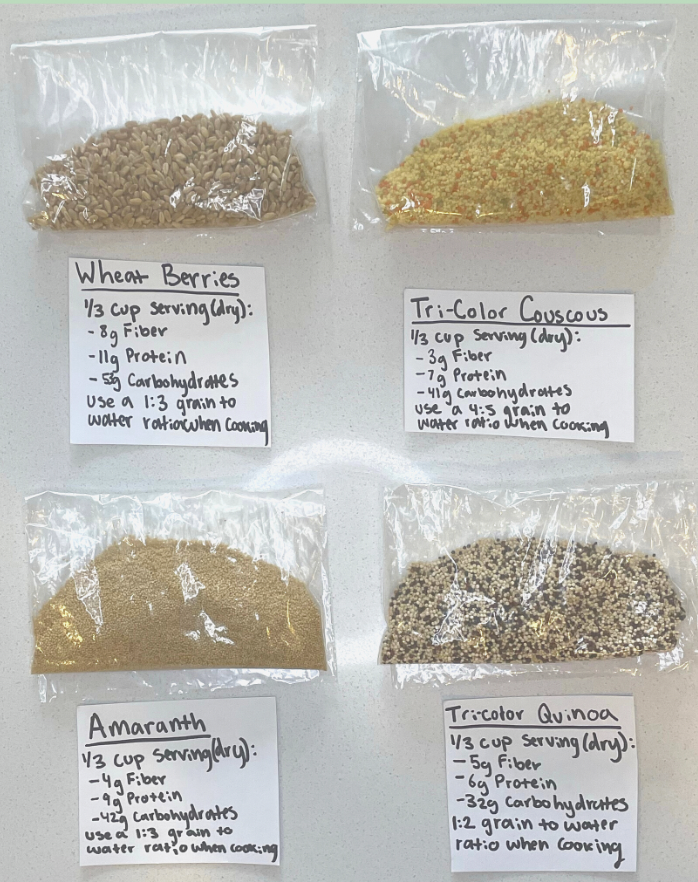

What is sustainable eating?
Sustainable eating is a practice that helps support sustainability in our food systems. Having sustainable food systems is important for the continued production of foods we have now, the cost of growing and producing food products, the environment/ global warming, our future generation’s ability to produce food, and more. Though sustainable eating is important, it does not mean you have to go completely vegan, eat organic foods, and never go to chick-fil-a again. There are many other ways to help with sustainability without completely changing your life or spending a ton of money.
Plant-based diets and meals are a growing popularity to help with sustainability. There are some amazing recipes online on how to make plant-based meals. Meals that are planted based tend to naturally be more nutrient-dense and include more fiber/vegetables/whole grains. An easy way to start implementing this is participating in meatless Monday or reducing your animal product intake to only 1or 2 meals a day.
Another way to save some money and help with sustainability is by buying local products. If you are living in Cache Valley a great example of doing this is buying dairy and dairy products that are produced/manufactured in the valley. This also goes for produce, meat, poultry, eggs, and pretty much anything that would have to be transported a long distance. Reducing the need for transportation helps with sustainability in multiple ways. Buying vegetables in season also helps with sustainability in part because of transportation but also because additional resources are needed to grow out of season produce.
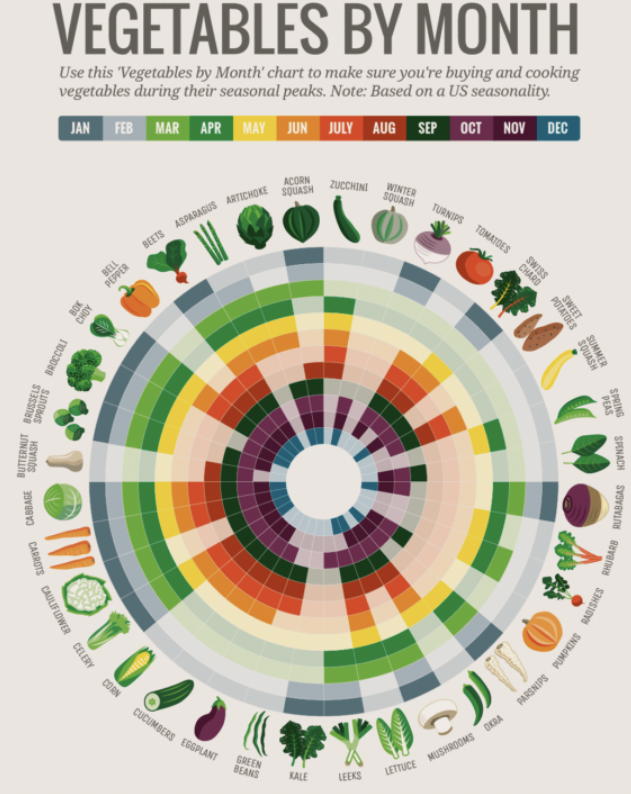
Cost Breakdown
| Ingredient | Amount | Ap Unit Cost | Recipe Ingredient Cost |
| Chickpea | 1 Tbsp | 0.72/ 16 oz can | 0.72 |
| Olive Oil | 1 Tbsp | 2.52/ 16.9 oz (~33 Tbsp) | 0.08 |
| Garlic Powder | 1 tsp | 0.318/ 1 oz (1 oz~6 tsp) | 0.06 |
| Italian Seasoning | 1/2 tsp | 0.286/ 1 oz (1 oz~6 tsp) | 0.02 |
| Salt and Pepper | To taste | – | – |
| Total Recipe Cost | – | – | 0.88 |
| Cost Per Serving (1) | – | – | 0.88 |
| Ingredient | Amount | AP Unit Cost | Recipe Ingredient Cost |
| Quinoa | 2 cups uncooked | 2.59/ 1lb (0.41 lb~ 1 cup) | 2.12 |
| Vegetable 1 (cherry tomatoes) | 16 oz (48 tomatoes) | 1.48/ 10 oz (~30 tomatoes) | 2.40 |
| Vegetable 2 (large cucumber) | 2 | 0.87/ cucumber | 1.74 |
| Hummus | 3/4 | 2.98/ 14 oz container (~28 Tbsp) | 1.32 |
| Lemon juice | 6 tsp | .98/4.5 oz (~27 tsp) | 0.24 |
| Salt and pepper | To taste | – | – |
| Feta Cheese (optional) | 6 oz (~12 Tbsp) | 5.88/12 oz (~24 Tbsp) | 2.94 |
| Roasted Chickpeas (optional) | 1 serving (1.5 cups) | 0.85/ 1 serving | 0.88 |
| Total Recipe Cost | – | – | 7.82 |
| Cost per serving (6) | – | – | 1.30 |
| Total Recipe cost (with optional ingredients) | – | – | 11.64 |
| Cost per serving (with optional ingredients) (6) | – | – | 1.95 |
Cost of Eating Healthy/Sustainably
There are so many different ways to save money on food out there so for now I’m going to focus on ways to save for this recipe. Buy vegetables in-season really is a change saver. For this recipe, the two vegetables used are cucumbers and tomatoes. Both tend to be in season July-November. But this recipe can be used year-round with other vegetables. For example, broccoli and carrots are both in season when cucumbers and tomatoes are not and could be used for the two vegetables. Another way to save money is buying things in bulk and not buying name-brand products. For this recipe, the quinoa could be bought at a store like Winco which has a huge bulk foods section where you can get the exact amount of what you are looking for. You can also buy in bulk for the seasonings, salt, and pepper. When trying to reduce the cost of lemon juice and feta cheese the best option is to buy the cheapest brand. If you are making the option roasted chickpeas an easy way to reduce the price is to buy dry chickpeas in bulk instead of canned but this does require extra time and knowledge on how to cook dry chickpeas.
This meal is a healthy and sustainable option that is filling and not too expensive. Shown above is a cost breakdown of the main recipe and the optional addition of roasted chickpeas. The grain bowl costs only $1.95 per serving and might be less depending on what/when ingredients are bought.
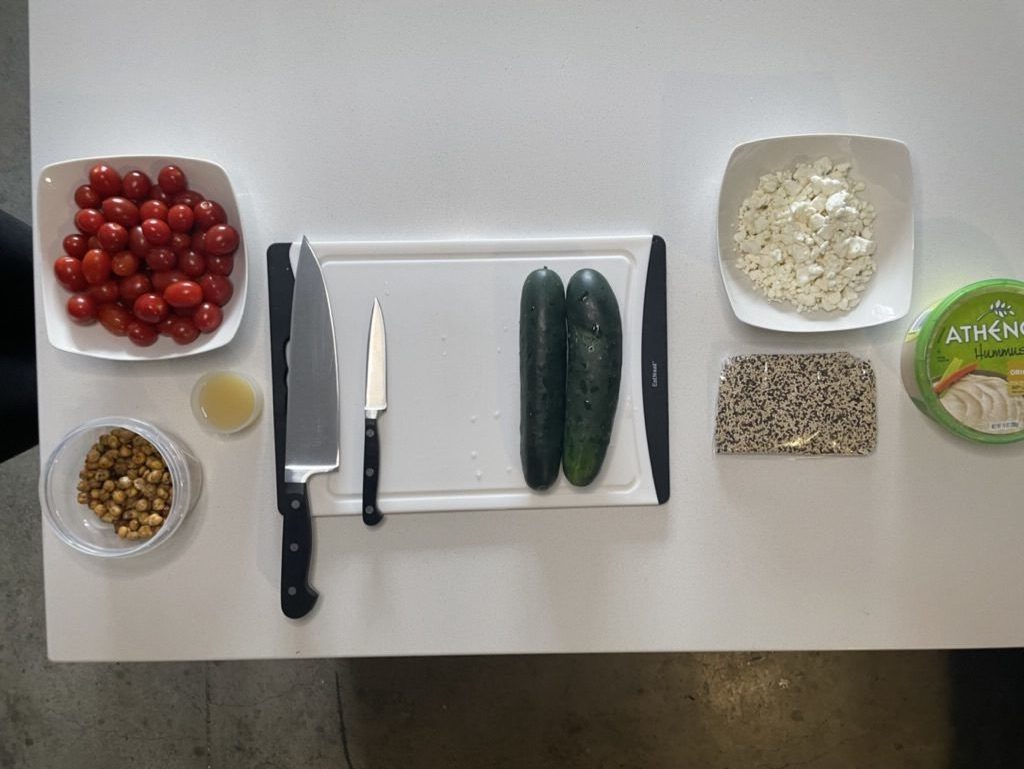

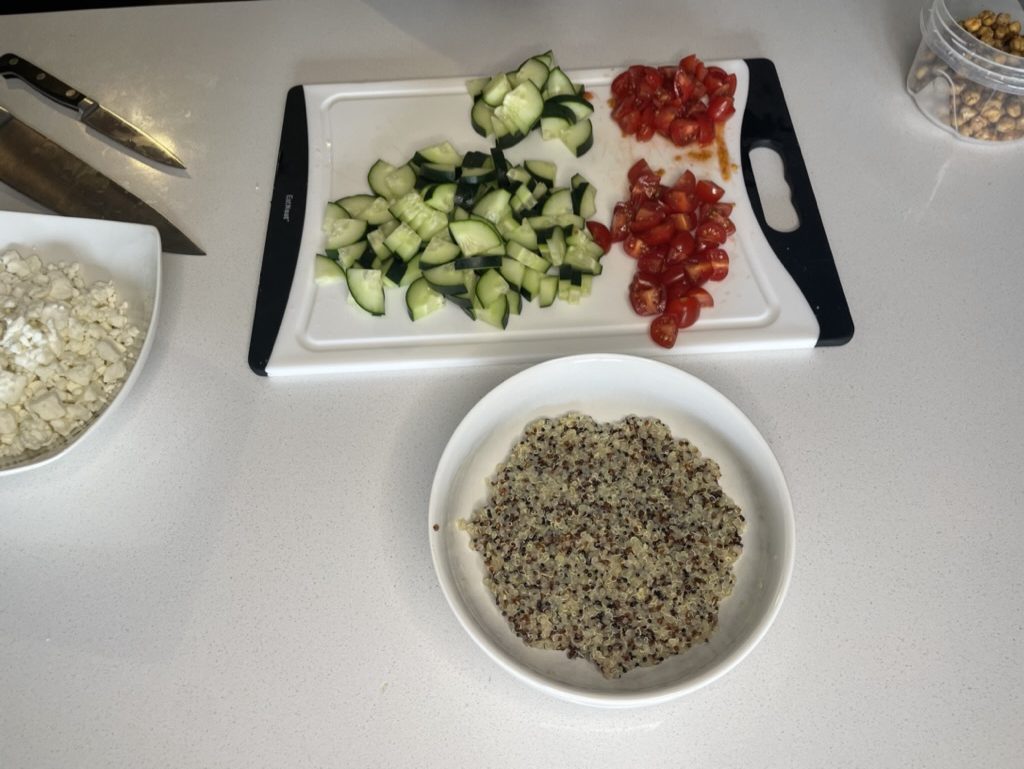
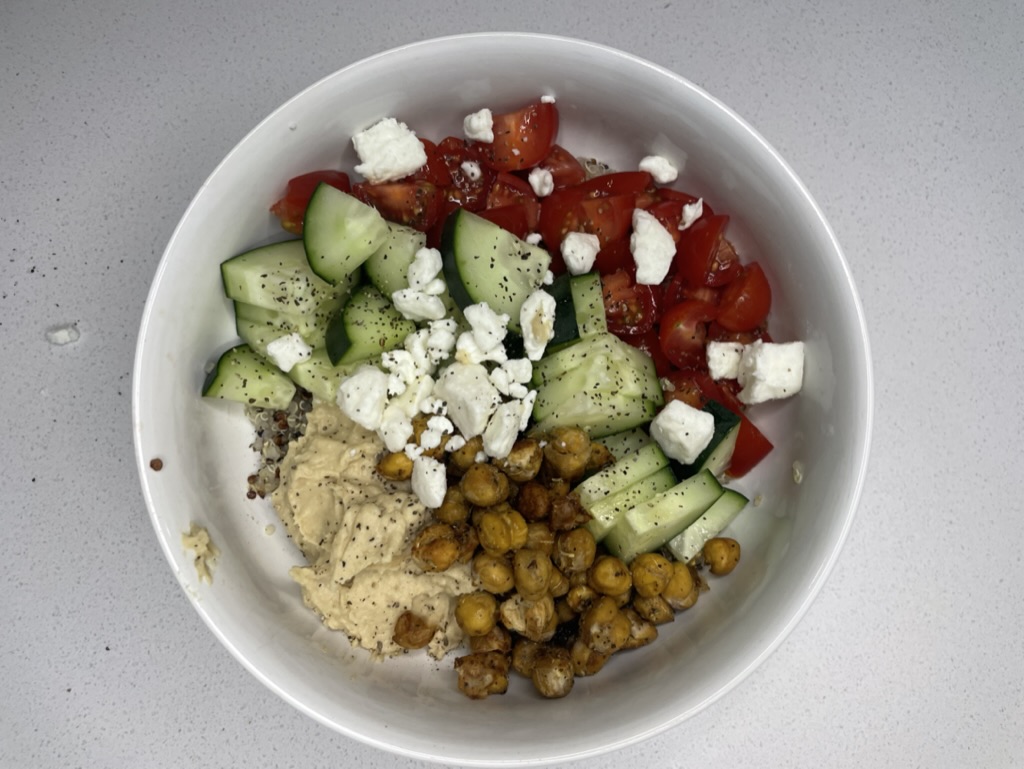
Mediterranean Grain Bowl
Ingredients
Instructions
- Start by rinsing the quinoa. Once rinsed bring water to a boil. Once boiling add the quinoa, reduce heat, and let simmer covered for 15 minutes.
- Remove quinoa from heat and let sit cover for 10 additional minutes.
- Start by rinsing the quinoa. While quinoa is cooking cut tomatoes and cucumbers into small bite-sized pieces (cutting the tomatoes into four pieces and slicing cucumbers then cutting the slices into fourths). When quinoa is done add lemon juice and stir in.
- Divide the quinoa into 6 meal prep containers or bowls. Top each bowl with the vegetables (about 8 cherry tomatoes and ⅓ of a cucumber), hummus (about 2 Tablespoons per bowl), feta cheese (about 2 Tablespoons per bowl), roasted chickpeas (about ¼ cup), and salt and pepper to taste.
References and Resources
Here is a link with some additional things that can be done to help sustainable
food systems. https://www.greenamerica.org/good-food-gone-local/9-ways-
support-sustainable-food None of these has to be done to 100% to be helpful if
you can only implement some of these things occasionally it is better than
nothing.
This link talks about sustainability and plant-based eating.
https://www.sustain.ucla.edu/food-systems/the-case-for-plant-based/ and
this link give some recipes for those living a college lifestyle to start plant-based
eating. https://theveganatlas.com/16-easy-vegan-meals-to-make-in-your-
college-dorm-kitchen/
This website has a chart to see what common vegetables are in season.
https://www.cooksmarts.com/articles/vegetables-month-infographic-
eatmoreveggies/
Here is a great resource for replacing rice with other grains.
https://longevitylive.com/anti-aging/grain-alternative/
This website has a resource where you can figure out your specific
recommendations for different food groups and has general tips for adding food
groups into your diet. https://www.myplate.gov/
https://www.preparedfoods.com/articles/123403-consumer-sustainable-
eating-considerations-continue-to-rise
https://www.eatsamazing.co.uk/family-friendly-recipes/snack-ideas-
recipes/easy-garlic-herb-roasted-chickpeas-recipe

